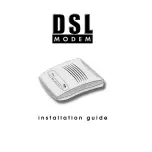
IES-1248-51 User’s Guide
110
Chapter 16 xDSL Port Setup
For example, you could set up different profiles for different kinds of accounts (for example,
economy, standard and premium). Assign the appropriate profile to an ADSL port and it takes
care of a large part of the port’s configuration maximum and minimum transfer rates. You still
get to individually enable or disable each port, as well as configure its channels and
operational mode.
16.4 Interleave Delay
Interleave delay is the wait (in milliseconds) that determines the size of a single block of data
to be interleaved (assembled) and then transmitted. Interleave delay is used when transmission
error correction (Reed- Solomon) is necessary due to a less than ideal telephone line. The
bigger the delay, the bigger the data block size, allowing better error correction to be
performed.
Reed-Solomon codes are block-based error correcting codes with a wide range of applications.
The Reed-Solomon encoder takes a block of digital data and adds extra "redundant" bits. The
Reed-Solomon decoder processes each block and attempts to correct errors and recover the
original data.
16.4.1 Fast Mode
Fast mode means no interleaving takes place and transmission is faster (a “fast channel”). This
would be suitable if you have a good line where little error correction is necessary.
16.5 Configured Versus Actual Rate
You configure the maximum rate of an individual ADSL port by modifying its profile (see
) or assigning the port to a different profile (see
). However, due to noise and other factors on the line, the actual rate may not reach the
maximum that you specify.
Even though you can specify arbitrary numbers using the Edit Profile screen, the actual rate is
always a multiple of 32 Kbps. If you enter a rate that is not a multiple of 32 Kbps, the actual
rate will be the next lower multiple of 32Kbps. For instance, if you specify 60 Kbps for a port,
the actual rate for that port will not exceed 32 Kbps, and if you specify 66 Kbps, the actual rate
will not be over 64Kbps.
Regardless of a profile’s configured upstream and downstream rates, the IES-1248-51
automatically limits the actual rates for each individual port to the maximum speeds supported
by the port’s ADSL operational mode. For example, if you configure a profile with a
maximum downstream rate of 25000 Kbps, and apply it to a port set to use G.dmt, the IES-
1248-51 automatically uses a maximum downstream rate of 8160 Kbps. This means that if you
configure a profile with very high rates, you can still use it with any port. See
for a list of the maximum rates supported by the different ADSL standards.
Summary of Contents for IES-1248-51
Page 1: ...IES 1248 51 ADSL2 IP DSLAM User s Guide Version 3 51 ABQ 1 3 2006 ...
Page 4: ...IES 1248 51 User s Guide 4 Interference Statements and Warnings ...
Page 22: ...IES 1248 51 User s Guide 22 Table of Contents Index 379 ...
Page 30: ...IES 1248 51 User s Guide 30 List of Figures ...
Page 34: ...IES 1248 51 User s Guide 34 List of Tables ...
Page 48: ...IES 1248 51 User s Guide 48 Chapter 2 Hardware Installation ...
Page 62: ...IES 1248 51 User s Guide 62 Chapter 4 MDF Connections ...
Page 73: ...IES 1248 51 User s Guide Chapter 7 Introducing the Web Configurator 73 Figure 29 Logout ...
Page 74: ...IES 1248 51 User s Guide 74 Chapter 7 Introducing the Web Configurator ...
Page 88: ...IES 1248 51 User s Guide 88 Chapter 9 Home and Port Statistics Screens ...
Page 90: ...IES 1248 51 User s Guide 90 Chapter 10 System Information Figure 44 System Info ...
Page 98: ...IES 1248 51 User s Guide 98 Chapter 12 User Account ...
Page 104: ...IES 1248 51 User s Guide 104 Chapter 13 Switch Setup ...
Page 106: ...IES 1248 51 User s Guide 106 Chapter 14 IP Setup ...
Page 126: ...IES 1248 51 User s Guide 126 Chapter 16 xDSL Port Setup ...
Page 140: ...IES 1248 51 User s Guide 140 Chapter 17 xDSL Profiles Setup ...
Page 154: ...IES 1248 51 User s Guide 154 Chapter 19 VLAN ...
Page 188: ...IES 1248 51 User s Guide 188 Chapter 28 2684 Routed Mode ...
Page 192: ...IES 1248 51 User s Guide 192 Chapter 30 Syslog ...
Page 210: ...IES 1248 51 User s Guide 210 Chapter 33 Alarm ...
Page 240: ...IES 1248 51 User s Guide 240 Chapter 38 Commands ...
Page 256: ...IES 1248 51 User s Guide 256 Chapter 40 Alarm Commands ...
Page 262: ...IES 1248 51 User s Guide 262 Chapter 41 DHCP Relay Commands ...
Page 282: ...IES 1248 51 User s Guide 282 Chapter 44 IGMP Commands ...
Page 286: ...IES 1248 51 User s Guide 286 Chapter 45 Packet Filter Commands ...
Page 292: ...IES 1248 51 User s Guide 292 Chapter 46 IP Commands ...
Page 302: ...IES 1248 51 User s Guide 302 Chapter 48 SNMP ...
Page 338: ...IES 1248 51 User s Guide 338 Chapter 49 ADSL Commands ...
Page 358: ...IES 1248 51 User s Guide 358 Chapter 50 Virtual Channel Management ...
Page 370: ...IES 1248 51 User s Guide 370 Chapter 51 Troubleshooting ...
Page 378: ...IES 1248 51 User s Guide 378 ...
















































